Dubai’s Roads and Transport Authority (RTA) has unveiled an 800-meter tunnel featuring four lanes in each direction, as part of the Umm Suqeim Street Development Project. This project stretches from the intersection with Al Khail Road to the intersection with Sheikh Mohammed bin Zayed Road. It is a key element of RTA’s ongoing initiatives to enhance road infrastructure, catering to Dubai’s continuous urban and population expansion while improving traffic flow. The development benefits several residential and community areas, collectively housing over one million residents.
His Excellency Mattar Al Tayer, director general and chairman of the Board of Executive Directors of Dubai’s Roads and Transport Authority (RTA), stated: “The Umm Suqeim Street Development Project extends from the intersection with Al Khail Road to the intersection with Sheikh Mohammed bin Zayed Road, covering a distance of 4.6 km. The works included upgrading the intersection of Umm Suqeim Street with Al Barsha South Street, near Kings’ School, where an 800-meter-long underpass with four lanes in each direction was constructed, in addition to a signalised surface-level intersection.”
“The completed project is part of a comprehensive plan to develop the Umm Suqeim–Al Qudra corridor, which extends from the intersection with Jumeirah Street to the intersection with Emirates Road, spanning a total of 16 km. This development is regarded as one of the most crucial strategic projects for enhancing transverse east–west roads to improve connectivity with vertical north–south roads. The completion of the project complements RTA’s efforts to upgrade this corridor,” he added.

Connectivity improvements
Al Tayer further explained: “The project improves connectivity between four strategic corridors in Dubai: Sheikh Zayed Road, Al Khail Road, Sheikh Mohammed bin Zayed Road, and Emirates Road. It increas es the capacity of Umm Suqeim Street to 16,000 vehicles per hour in both directions, enhances traffic flow, and reduces travel time between Sheikh Mohammed bin Zayed Road and Al Khail Road by 61 percent, from 9.7 minutes to 3.8 minutes. It also serves several residential and development areas, including Al Barsha South 1, 2, and 3, Dubai Hills, Arjan, and Dubai Science Park, which together host a population exceeding one million.”
es the capacity of Umm Suqeim Street to 16,000 vehicles per hour in both directions, enhances traffic flow, and reduces travel time between Sheikh Mohammed bin Zayed Road and Al Khail Road by 61 percent, from 9.7 minutes to 3.8 minutes. It also serves several residential and development areas, including Al Barsha South 1, 2, and 3, Dubai Hills, Arjan, and Dubai Science Park, which together host a population exceeding one million.”
Moreover, Al Tayer highlighted that RTA utilized cutting-edge smart technologies to oversee progress on the Umm Suqeim Street Development Project. Drones were employed to analyse construction data using artificial intelligence, enhancing operational efficiency on-site, expediting decision-making, and providing real-time, highly precise information. These technologies also doubled on-site presence, cut the duration of field surveys by 60 percent, and improved overall monitoring. Additionally, time-lapse imaging was used to continuously track construction progress, increasing monitoring efficiency by 40 percent.
Pedestrian safety features
In 2013, RTA completed Phase I of the Umm Suqeim Street Development Project, which encompassed the section between Sheikh Zayed Road and Al Khail Road. This phase included the construction of two bridges, each featuring three lanes in both directions, with one crossing the eastern street parallel to Al Asayel Street and the other crossing the western street parallel to First Al Khail Road. The phase also involved the development of two signalised intersections at the junctions of Umm Suqeim Street with Al Asayel Street and First Al Khail Road, in addition to three pedestrian bridges along Umm Suqeim Street to ensure safe crossing between Al Quoz and Al Barsha areas.
In 2020, as part of the bridges and roads project for Dubai Hills Mall, RTA inaugurated a significant bridge on Umm Suqeim Street at its intersection with the entrance to Dubai Hills and Al Barsha South. The bridge spans 500 meters, features four lanes in each direction, and provides a capacity of 16,000 vehicles per hour in both directions.
Travel time improvements
In 2024 and continuing into 2025, Dubai’s RTA intensified the Umm Suqeim Street Development Project, significantly advancing infrastructure improvements to reduce congestion and support urban growth. As of May 2025, RTA announced that approximately 70 percent of the project was completed, focusing on enhancing the corridor extending from Al Khail Road to Sheikh Mohammed bin Zayed Road. The project now includes multiple tunnels and bridges that stretch over 4,100 meters of infrastructure with four lanes in each direction, strategically designed to increase the road’s capacity to 16,000 vehicles per hour both ways. Travel times have been cut dramatically, with journeys reduced by 61 percent, from 9.7 minutes down to just 3.8 minutes between Sheikh Mohammed bin Zayed Road and Al Khail Road, substantially improving commuter experience and easing traffic flow.
The 2024-2025 phase of development incorporated major renovations of six key intersections, including Jumeirah Street, Al Wasl Road, Sheikh Zayed Road, and Al Khail Road. Innovations such as cycle lanes, widened sidewalks, and green spaces were introduced to promote sustainable and soft mobility options alongside vehicle traffic. The project also enhanced pedestrian zones and safety features, aiming to improve livability and support car-free travel in adjacent communities such as Jumeirah, Umm Suqeim, Al Manara, Al Sufouh, Um Al Sheif, Al Barsha, and Al Quoz, which collectively house more than two million residents.
The RTA’s use of smart technologies remained a cornerstone, with artificial intelligence-enabled drones providing real-time data for optimized construction monitoring and decision-making. This technology was credited with boosting operational efficiency by 40 percent and doubling onsite presence, significantly accelerating project timelines while maintaining high safety and quality standards.








